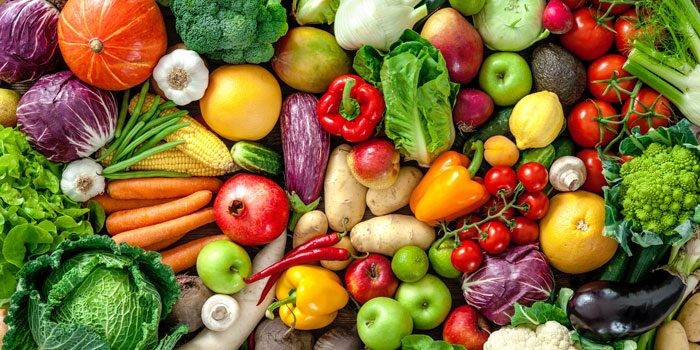Wrinkles and age spots are a natural part of aging, often accelerated by sun exposure, tanning beds, harsh skincare products, and an unbalanced diet. Optimizing your nutrition is key, alongside a tailored skincare routine and lifestyle adjustments. A balanced diet, abundant in antioxidant-rich fruits and vegetables, healthy fats from oily fish and nuts, and proper hydration, is your secret weapon.
Here are 10 expert tips on how to eat your way to radiant, healthy skin:
1. Aim for at Least Five Portions of Fruits and Vegetables Daily
Fruits and vegetables are packed with potent antioxidants that shield your skin from cellular damage caused by free radicals. These harmful free radicals can be triggered by factors like smoking, pollution, and sun exposure.
Prioritize a vibrant mix of colorful fruits and vegetables – aim for at least five portions each day. Beta-carotene, abundant in orange produce such as carrots, sweet potatoes, and pumpkins, along with lutein found in kale, papaya, and spinach, are crucial for healthy skin cell development and a radiant skin tone.
2. Prioritize Vitamin C Intake
Vitamin C is essential for supporting the immune system, promoting glowing skin, and accelerating the healing of blemishes. Excellent sources include blackcurrants, blueberries, broccoli, guava, kiwi, oranges, papaya, strawberries, and sweet potatoes.
Vitamin C is also vital for collagen production. Collagen is a protein that provides structure and support, keeping skin firm and strengthening the blood vessels that nourish it.
3. Consume Adequate Vitamin E
Vitamin E is key in protecting the skin from oxidative (cell) damage and photo-aging, or premature aging caused by sun exposure. Foods rich in vitamin E include almonds, avocados, hazelnuts, pine nuts, and sunflower and pumpkin seed oil.
4. Increase Selenium Consumption
Selenium is a powerful antioxidant that works in synergy with vitamins C and E. Studies suggest a diet rich in selenium may help protect against skin cancer, sun damage, and age spots. Brazil nuts are an excellent source – just two or three provide your recommended daily amount. Other good sources include fish, shellfish, eggs, wheat germ, tomatoes, and broccoli.
5. Include Plenty of Zinc
Zinc supports the normal function of oil-producing glands in the skin, helping maintain its suppleness. It also plays a role in the healing process and helps repair skin damage. Zinc-rich foods include fish, lean red meat, wholegrains, poultry, nuts, seeds, and shellfish.
6. Incorporate Healthy Fats
Healthy fats act as a natural moisturizer, maintaining skin suppleness and improving elasticity from the inside out. These include monounsaturated and polyunsaturated fats found in avocados, oily fish, nuts, and seeds, often packaged with valuable vitamin E.
Focus on omega-3 fatty acids, a type of polyunsaturated fat. These are anti-inflammatory and may help alleviate skin conditions like eczema and psoriasis. They’re also crucial for building healthy skin. Excellent sources are oily fish (salmon, trout, sardines) and plant sources (flaxseed, chia seeds, walnuts, and rapeseed oil).
7. Consume More Phytoestrogens
Phytoestrogens are natural plant compounds with a structure similar to the female sex hormone estrogen. They are believed to help balance our natural hormones, which is important for skin health, especially in supporting skin structure and minimizing damage. Soybeans (isoflavones) such as tofu and tempeh, and lignans found in wholegrains, fruits, vegetables, and flaxseed are good sources.
8. Drink Six to Eight Glasses of Water Daily
Skin needs moisture to stay flexible. Even mild dehydration can make your skin look dry, tired, and dull. Aim for six to eight glasses of water per day. While all fluids contribute, water is the best choice. Herbal teas are also a good option. Some fruits and vegetables like watermelon, zucchini, and cucumber also contribute fluids, along with beneficial minerals that enhance hydration.
9. Opt for Low-Glycemic Index (GI) Carbohydrates
The glycemic index (GI) ranks carbohydrate-based foods based on how quickly they are broken down into glucose in the body. Prioritize beans, pulses, porridge, and other low-GI, slow-releasing carbohydrates. These provide a steady energy supply and help you feel full, reducing the likelihood of snacking. Avoid high-GI carbohydrates such as biscuits and sugary drinks, which can lead to insulin production, potentially damaging collagen and accelerating wrinkles.
10. Avoid Crash Dieting
Repeated weight loss and gain can negatively impact your skin, leading to sagging, wrinkles, and stretch marks. Crash diets often lack essential vitamins and minerals, which will reflect negatively on your skin over time.
Smoking and excessive alcohol consumption are also lifestyle factors that significantly impact the appearance of your skin.
The Bottom Line
Nourishing your body with the right foods is a powerful way to support healthy, radiant skin. By incorporating these top 10 tips into your daily diet, you can optimize your skin’s health and achieve a glowing complexion from the inside out. Remember to consult with a healthcare professional or registered dietitian for personalized advice.
